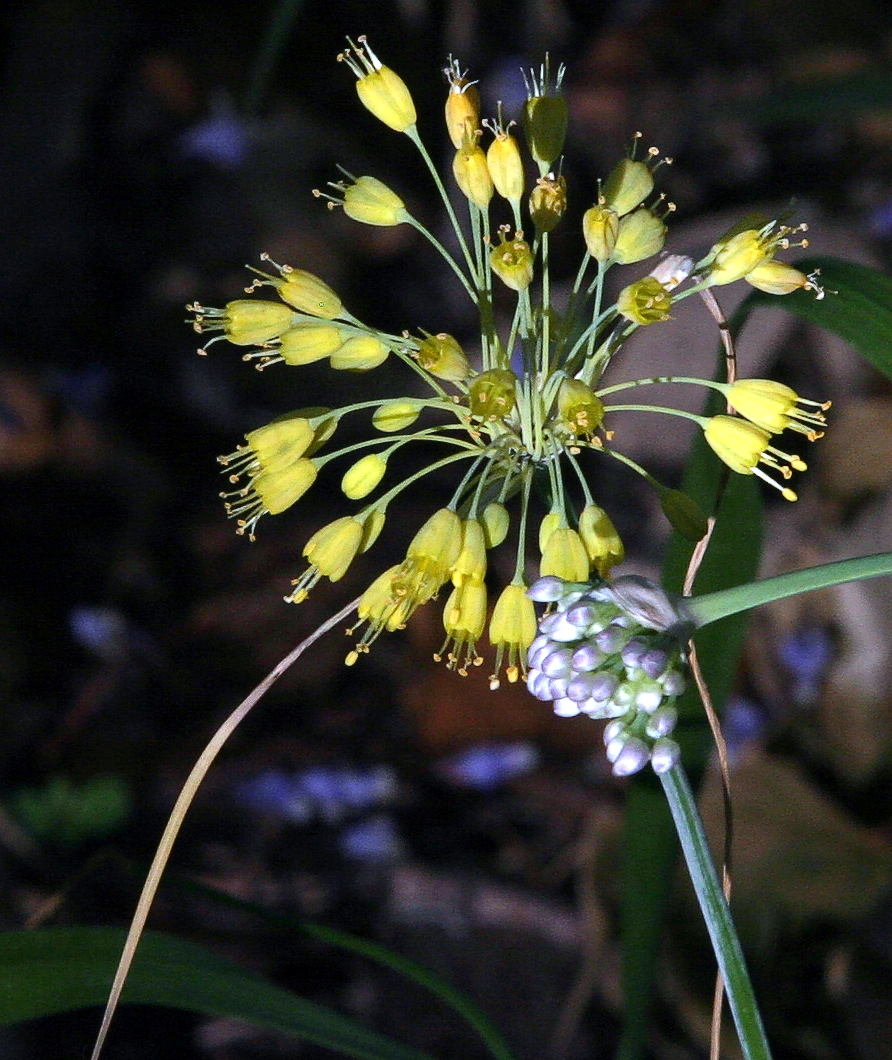- Allium
Taxobox
name = "Allium"

image_width = 250px
image_caption = Allium species from Russia
regnum =Plantae
phylum = Magnoliophyta
classis =Liliopsida
ordo =Asparagales
familia =Alliaceae
genus = "Allium"
genus_authority = L.
subdivision_ranks = Species
subdivision = Some important species:
"Allium acuminatum " - tapertip onion
"Allium ampeloprasum " - (Broadleaf) wild leek
:"A. a." var. "ampeloprasum" -elephant garlic
:"A. a." var. "kurrat" -kurrat
:"A. a." var. "porrum" - leek
"Allium anceps " - twinleaf onion
"Allium angulosum " - mouse garlic
"Allium aflatunense " - purple sensation
"Allium atrorubens " - dark red onion
"Allium caeruleum " - blue globe onion
"Allium campanulatum " - dusky onion
"Allium canadense " - Canadian garlic
"Allium cepa " - garden onion
"Allium cernuum " - nodding onion
"Allium chinense "
"Allium fistulosum" - Welsh onion
"Allium giganteum " - giant onion
"Allium neapolitanum " - white garlic
"Allium nevii " - Nevius' garlic
"Allium nigrum " - black garlic
"Allium oleraceum " - field garlic
"Allium oschaninii" - shallot
"Allium ramosum " - wild Chinese chives
"Allium sativum " - cultivated garlic
"Allium schoenoprasum " - chives
"Allium scorodoprasum " - Sand leek
"Allium textile " - prairie onion
"Allium tricoccum " - wild leek, ramp
"Allium triquetrum " - three-cornered leek, triquetous garlic
"Allium tuberosum" - Chinese chives
"Allium ursinum " - wild garlic, ramsons
"Allium vineale " - crow garlic, wild onion
See full list."Allium" is the
onion genus , with about 1250species , making it one of the largest plant genera in the world. They are perennial bulbous plants that produce chemical compounds (mostly cystein sulfoxide) that give them a characteristic onion or garlic taste and odor, and many are used as food plants. "Allium" is classified in familyAlliaceae although some classifications have included it in thelily family (Liliaceae )."Allium" species occur in
temperate climate s of thenorthern hemisphere , except for a few species occurring in Chile (as "Allium juncifolium"), Brazil ("Allium sellovianum") or tropical Africa ("Allium spathaceum"). They can vary in height between 5 cm and 150 cm. Theflower s form anumbel at the top of a leafless stalk. Thebulb s vary in size between species, from very small (around 2–3 mm in diameter) to rather big (8–10 cm). Some species (such as Welsh onion, "A. fistulosum") develop thickened leaf-bases rather than forming bulbs as such.Most bulbous alliums increase by forming little bulbs or "offsets" around the old one, as well as by
seed . Several species can form many bulbils (tiny bulbs) in the flowerhead; in the so-called "tree onion " ("A. cepa" Proliferum Group) the bulbils are few, but large enough to be used forpickling .Members of the genus include many valued
vegetable s such asonion s,shallots , leeks andherb s such asgarlic andchives . A strong "oniony" odor is characteristic of the whole genus, but not all members are equally flavorful.Some "Allium" species, including "A. cristophii" and "A. giganteum", are used as border plants for their flowers, and their "architectural" qualities. Several hybrids have been bred, or selected, with rich purple flowers. "Allium hollandicum" 'Purple Sensation' is one of the most popular and has been given an
Award of Garden Merit (H4). By contrast, other species (such as the invasive "Allium triquetrum") can become troublesome gardenweed s.Various "Allium" species are used as food plants by the
larva e of someLepidoptera includingCabbage Moth , Common Swift moth (recorded on garlic),Garden Dart moth,Large Yellow Underwing moth, Nutmeg moth,Setaceous Hebrew Character moth,Turnip Moth and "Schinia rosea", a moth which feeds exclusively on "Allium sp".External links
* [http://www.bloomsta.com Bloomsta.com Florist Community]
Wikimedia Foundation. 2010.
